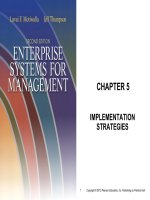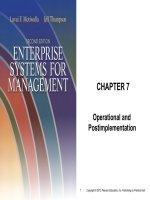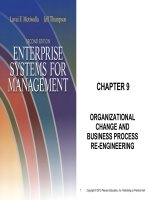Principles of operations management 9th by heizer and render chapter 07s
Bạn đang xem bản rút gọn của tài liệu. Xem và tải ngay bản đầy đủ của tài liệu tại đây (911.42 KB, 60 trang )
7
SUPPLEMENT
Capacity and
Constraint
Management
PowerPoint presentation to accompany
Heizer and Render
Operations Management, Eleventh Edition
Principles of Operations Management, Ninth Edition
PowerPoint slides by Jeff Heyl
© 2014
© 2014
Pearson
Pearson
Education,
Education,
Inc.Inc.
S7 - 1
Outline
►
►
►
►
Capacity
Bottleneck Analysis and the Theory
of Constraints
Break-Even Analysis
Reducing Risk with Incremental
Changes
© 2014 Pearson Education, Inc.
S7 - 2
Outline - Continued
►
►
Applying Expected Monetary Value
(EMV) to Capacity Decisions
Applying Investment Analysis to
Strategy-Driven Investments
© 2014 Pearson Education, Inc.
S7 - 3
Learning Objectives
When you complete this supplement
you should be able to :
1. Define capacity
2. Determine design capacity, effective
capacity, and utilization
3. Perform bottleneck analysis
4. Compute break-even
© 2014 Pearson Education, Inc.
S7 - 4
Learning Objectives
When you complete this supplement
you should be able to :
5. Determine the expected monetary
value of a capacity decision
6. Compute net present value
© 2014 Pearson Education, Inc.
S7 - 5
Capacity
►
The throughput, or the number of units
a facility can hold, receive, store, or
produce in a period of time
►
Determines
fixed costs
►
Determines if
demand will
be satisfied
►
Three time horizons
© 2014 Pearson Education, Inc.
S7 - 6
Planning Over a Time Horizon
Figure S7.1
Time Horizon
Options for Adjusting Capacity
Long-range
planning
Add facilities
Add long lead time equipment
Intermediaterange
planning
(aggregate
planning)
Subcontract
Add equipment
Add shifts
Short-range
planning
(scheduling)
*
Add personnel
Build or use inventory
*
Modify capacity
Schedule jobs
Schedule personnel
Allocate machinery
Use capacity
* Difficult to adjust capacity as limited options exist
© 2014 Pearson Education, Inc.
S7 - 7
Design and Effective Capacity
►
Design capacity is the maximum
theoretical output of a system
►
►
Normally expressed as a rate
Effective capacity is the capacity a firm
expects to achieve given current
operating constraints
►
Often lower than design capacity
© 2014 Pearson Education, Inc.
S7 - 8
Utilization and Efficiency
Utilization is the percent of design
capacity actually achieved
Utilization = Actual output/Design capacity
Efficiency is the percent of effective
capacity actually achieved
Efficiency = Actual output/Effective capacity
© 2014 Pearson Education, Inc.
S7 - 9
Bakery Example
Actual production last week = 148,000 rolls
Effective capacity = 175,000 rolls
Design capacity = 1,200 rolls per hour
Bakery operates 7 days/week, 3 - 8 hour shifts
Design capacity = (7 x 3 x 8) x (1,200) = 201,600 rolls
© 2014 Pearson Education, Inc.
S7 - 10
Bakery Example
Actual production last week = 148,000 rolls
Effective capacity = 175,000 rolls
Design capacity = 1,200 rolls per hour
Bakery operates 7 days/week, 3 - 8 hour shifts
Design capacity = (7 x 3 x 8) x (1,200) = 201,600 rolls
© 2014 Pearson Education, Inc.
S7 - 11
Bakery Example
Actual production last week = 148,000 rolls
Effective capacity = 175,000 rolls
Design capacity = 1,200 rolls per hour
Bakery operates 7 days/week, 3 - 8 hour shifts
Design capacity = (7 x 3 x 8) x (1,200) = 201,600 rolls
Utilization = 148,000/201,600 = 73.4%
© 2014 Pearson Education, Inc.
S7 - 12
Bakery Example
Actual production last week = 148,000 rolls
Effective capacity = 175,000 rolls
Design capacity = 1,200 rolls per hour
Bakery operates 7 days/week, 3 - 8 hour shifts
Design capacity = (7 x 3 x 8) x (1,200) = 201,600 rolls
Utilization = 148,000/201,600 = 73.4%
Efficiency = 148,000/175,000 = 84.6%
© 2014 Pearson Education, Inc.
S7 - 13
Bakery Example
Actual production last week = 148,000 rolls
Effective capacity = 175,000 rolls
Design capacity = 1,200 rolls per hour
Bakery operates 7 days/week, 3 - 8 hour shifts
Design capacity = (7 x 3 x 8) x (1,200) = 201,600 rolls
Utilization = 148,000/201,600 = 73.4%
Efficiency = 148,000/175,000 = 84.6%
© 2014 Pearson Education, Inc.
S7 - 14
Bakery Example
Actual production last week = 148,000 rolls
Effective capacity = 175,000 rolls
Design capacity = 1,200 rolls per hour
Bakery operates 7 days/week, 3 - 8 hour shifts
Efficiency = 84.6%
Efficiency of new line = 75%
Expected Output = (Effective Capacity)(Efficiency)
= (175,000)(.75) = 131,250 rolls
© 2014 Pearson Education, Inc.
S7 - 15
Bakery Example
Actual production last week = 148,000 rolls
Effective capacity = 175,000 rolls
Design capacity = 1,200 rolls per hour
Bakery operates 7 days/week, 3 - 8 hour shifts
Efficiency = 84.6%
Efficiency of new line = 75%
Expected Output = (Effective Capacity)(Efficiency)
= (175,000)(.75) = 131,250 rolls
© 2014 Pearson Education, Inc.
S7 - 16
Capacity and Strategy
►
Capacity decisions impact all 10
decisions of operations management
as well as other functional areas of
the organization
►
Capacity decisions must be integrated
into the organization’s mission and
strategy
© 2014 Pearson Education, Inc.
S7 - 17
Capacity Considerations
1. Forecast demand accurately
2. Match technology increments and
sales volume
3. Find the optimum operating size
(volume)
4. Build for change
© 2014 Pearson Education, Inc.
S7 - 18
Economies and Diseconomies
of Scale
Average unit cost
(sales per square foot)
Figure S7.2
1,300 sq ft
store
Economies
of scale
1,300
© 2014
© 2014
Pearson
Pearson
Education,
Education,
Inc.Inc.
2,600 sq ft
store
8,000 sq ft
store
Diseconomies
of scale
2,600
Number of square feet in store
8,000
S7 - 19
Managing Demand
►
►
►
Demand exceeds capacity
►
Curtail demand by raising prices, scheduling
longer lead time
►
Long term solution is to increase capacity
Capacity exceeds demand
►
Stimulate market
►
Product changes
Adjusting to seasonal demands
►
Produce products with complementary
demand patterns
© 2014 Pearson Education, Inc.
S7 - 20
Complementary Demand
Patterns
Figure S7.3
Combining the
two demand
patterns reduces
the variation
Sales in units
4,000 –
Snowmobile
motor sales
3,000 –
2,000 –
1,000 –
Jet ski
engine
sales
J F MAMJ JAS O N D J F MAMJ JAS ON D J
Time (months)
© 2014 Pearson Education, Inc.
S7 - 21
Tactics for Matching Capacity
to Demand
1. Making staffing changes
2. Adjusting equipment
►
Purchasing additional machinery
►
Selling or leasing out existing equipment
3. Improving processes to increase throughput
4. Redesigning products to facilitate more throughput
5. Adding process flexibility to meet changing product
preferences
6. Closing facilities
© 2014 Pearson Education, Inc.
S7 - 22
Service-Sector Demand
and Capacity Management
►
Demand management
►
►
Appointment, reservations, FCFS rule
Capacity
management
►
Full time,
temporary,
part-time
staff
© 2014 Pearson Education, Inc.
S7 - 23
Bottleneck Analysis and the
Theory of Constraints
►
Each work area can have its own unique
capacity
►
Capacity analysis determines the throughput
capacity of workstations in a system
►
A bottleneck is a limiting factor or constraint
►
A bottleneck has the lowest effective capacity
in a system
© 2014 Pearson Education, Inc.
S7 - 24
Bottleneck Analysis and the
Theory of Constraints
►
The bottleneck time is the time of the
slowest workstation (the one that takes
the longest) in a production system
►
The throughput time is the time it takes
a unit to go through production from start
to end
Figure S7.4
A
B
C
2 min/unit
4 min/unit
3 min/unit
© 2014 Pearson Education, Inc.
S7 - 25









